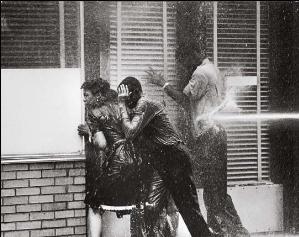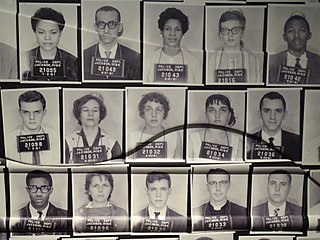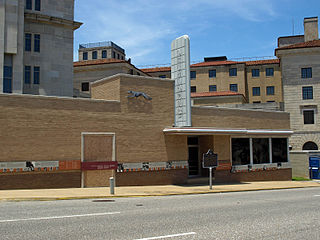
The Ku Klux Klan, commonly shortened to the KKK or the Klan is the name of several historical and current American white supremacist, far-right terrorist organizations and hate groups. Their primary targets are African Americans, Hispanics, Jews, Latinos, Asian Americans, Native Americans, and Catholics, as well as immigrants, leftists, homosexuals, Muslims, atheists, and abortion providers.
The Deacons for Defense and Justice was an armed African-American self-defense group founded in November 1964, during the civil rights era in the United States, in the mill town of Jonesboro, Louisiana. On February 21, 1965—the day of Malcolm X's assassination—the first affiliated chapter was founded in Bogalusa, Louisiana, followed by a total of 20 other chapters in this state, Mississippi, Arkansas, and Alabama. It was intended to protect civil rights activists and their families, threatened both by white vigilantes and discriminatory treatment by police under Jim Crow laws. The Bogalusa chapter gained national attention during the summer of 1965 in its violent struggles with the Ku Klux Klan.

Theophilus Eugene "Bull" Connor was an American politician who served as Commissioner of Public Safety for the city of Birmingham, Alabama, for more than two decades. A member of the Democratic Party, he strongly opposed the Civil Rights Movement in the 1960s. Under the city commission government, Connor had responsibility for administrative oversight of the Birmingham Fire Department and the Birmingham Police Department, which also had their own chiefs.

Viola Fauver Liuzzo was an American civil rights activist. In March 1965, Liuzzo heeded the call of Martin Luther King Jr. and traveled from Detroit, Michigan, to Selma, Alabama, in the wake of the Bloody Sunday attempt at marching across the Edmund Pettus Bridge. Liuzzo participated in the successful Selma to Montgomery marches and helped with coordination and logistics. At the age of 39, while driving back from a trip shuttling fellow activists to the Montgomery airport, she was fatally hit by shots fired from a pursuing car containing Ku Klux Klan members Collie Leroy Wilkins, Jr., William Orville Eaton, Eugene Thomas, and Gary Thomas Rowe, the last of whom was actually an undercover informant working for the Federal Bureau of Investigation (FBI).

Freddie Lee Shuttlesworth was an American civil rights activist who led the fight against segregation and other forms of racism as a minister in Birmingham, Alabama. He was a co-founder of the Southern Christian Leadership Conference, initiated and was instrumental in the 1963 Birmingham Campaign, and continued to work against racism and for alleviation of the problems of the homeless in Cincinnati, Ohio, where he took up a pastorate in 1961. He returned to Birmingham after his retirement in 2007. He worked with Martin Luther King Jr. during the civil rights movement, though the two men often disagreed on tactics and approaches.

John Malcolm Patterson was an American politician. He served one term as Attorney General of Alabama from 1955 to 1959, and, at age 37, served one term as the 44th Governor of Alabama from 1959 to 1963.

The Birmingham campaign, also known as the Birmingham movement or Birmingham confrontation, was an American movement organized in early 1963 by the Southern Christian Leadership Conference (SCLC) to bring attention to the integration efforts of African Americans in Birmingham, Alabama.

Freedom Riders were civil rights activists who rode interstate buses into the segregated Southern United States in 1961 and subsequent years to challenge the non-enforcement of the United States Supreme Court decisions Morgan v. Virginia (1946) and Boynton v. Virginia (1960), which ruled that segregated public buses were unconstitutional. The Southern states had ignored the rulings and the federal government did nothing to enforce them. The first Freedom Ride left Washington, D.C., on May 4, 1961, and was scheduled to arrive in New Orleans on May 17.

The Freedom Rides Museum is located at 210 South Court Street in Montgomery, Alabama, in the building which was until 1995 the Montgomery Greyhound Bus Station. It was the site of a violent attack on participants in the 1961 Freedom Ride during the Civil Rights Movement. The May 1961 assaults, carried out by a mob of white protesters who confronted the civil rights activists, "shocked the nation and led the Kennedy Administration to side with civil rights protesters for the first time."
The Alabama Christian Movement for Human Rights (ACMHR) was an American civil rights organization in Birmingham, Alabama, which coordinated boycotts and sponsored federal lawsuits aimed at dismantling segregation in Birmingham and Alabama during the civil rights movement. Fred Shuttlesworth, pastor of Bethel Baptist Church, served as president of the group from its founding in 1956 until 1969. The ACMHR's crowning moment came during the pivotal Birmingham campaign which it coordinated along with the Southern Christian Leadership Conference during the spring of 1963.
Charles Person is an African-American civil rights activist who participated in the 1961 Freedom Rides. He was born and raised in Atlanta, Georgia. Following his 1960 graduation from David Tobias Howard High School, he attended Morehouse College. Person was the youngest Freedom Rider on the original Congress of Racial Equality Freedom Ride. His memoir Buses Are a Comin': Memoir of a Freedom Rider was published by St. Martin's Press in 2021.
James Zwerg is an American retired minister who was involved with the Freedom Riders in the early 1960s.
William E. Harbour was an American civil rights activist who participated in the Freedom Rides. He was one of several youth activists involved in the latter actions, along with John Lewis, William Barbee, Paul Brooks, Charles Butler, Allen Cason, Catherine Burks, and Lucretia Collins.

The U.S. Klans, officially, the U.S. Klans, Knights of the Ku Klux Klan, Inc. was the dominant Ku Klux Klan in the late 1950s and early 1960s. The death of its leader in 1960, along with increased factionalism, splits and competition from other groups led to its decline by the mid-to-late 1960s.
The Original Ku Klux Klan of the Confederacy was a Klan faction led by Asa Carter in the late 1950s. Despite the group's brief lifespan, it left its mark with a violent record, including an assault on Nat King Cole, participation in a riot in Clinton, Tennessee, and one of the few documented cases of castration by the Klan.
The Birmingham riot of 1963 was a civil disorder and riot in Birmingham, Alabama, that was provoked by bombings on the night of May 11, 1963. The bombings targeted African-American leaders of the Birmingham campaign. In response, local African-Americans burned businesses and fought police throughout the downtown area.
Gary Thomas Rowe Jr., known in Witness Protection as Thomas Neil Moore, was a paid informant and agent provocateur for the FBI. As an informant, he infiltrated the Ku Klux Klan, as part of the FBI's COINTELPRO project, to monitor and disrupt the Klan's activities. Rowe participated in violent Klan activity against African Americans and civil rights groups.
Frederick Leonard is an American activist who was involved in the civil rights movement.
Catherine Burks-Brooks was an American civil rights movement activist, teacher, social worker, jewelry retailer, and newspaper editor.

The Anniston and Birmingham bus attacks, which occurred on May 14, 1961, in Anniston and Birmingham, both Alabama, were acts of mob violence targeted against civil rights activists protesting against racial segregation in the Southern United States. They were carried out by members of the Ku Klux Klan and the National States' Rights Party in coordination with the Birmingham Police Department. The FBI did nothing to prevent the attacks despite having foreknowledge of the plans.









